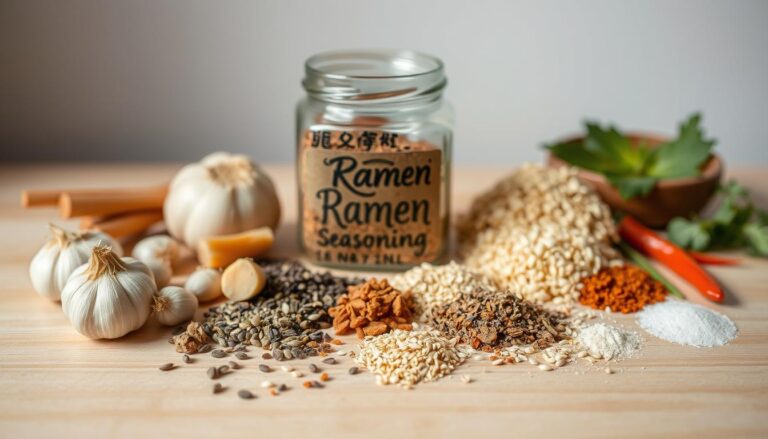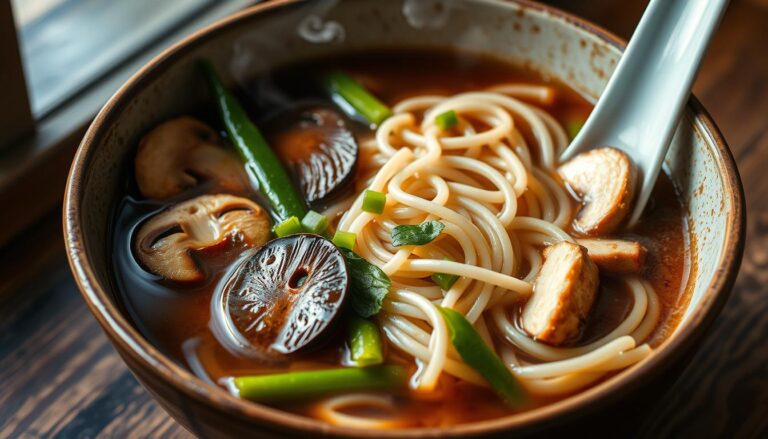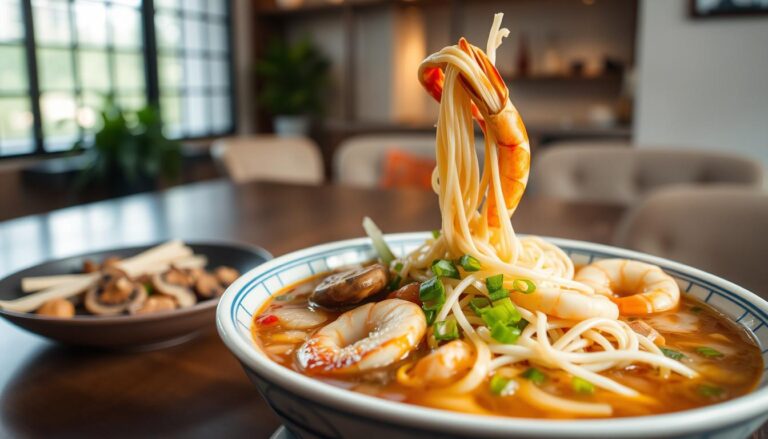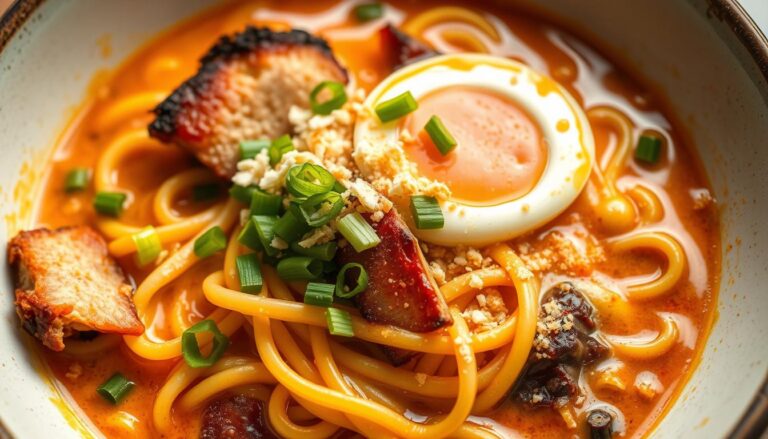Authentic Ichiraku Ramen Recipe: Recreate the Iconic Dish
Explore the world of Japanese cuisine with the legendary Ichiraku ramen recipe. It brings Naruto’s favorite dish to your kitchen. This ramen is more than a meal; it’s a journey through Japanese street food and anime-inspired cooking.
The Ichiraku ramen recipe comes from Tokushima Prefecture on Shikoku island. It captures the essence of Japanese noodle craftsmanship. Each bowl has a story of balanced flavors, prepared ingredients, and generations of expertise.
Making an authentic ramen broth is an art. It needs patience, skill, and understanding of flavor layering. I’ll show you how to turn simple ingredients into a complex, soul-warming dish.
This Ichiraku ramen recipe takes you to Japan’s bustling streets with every bite. The rich broth, perfectly cooked noodles, and tender chashu pork are all crafted for an unforgettable experience.
If you love Naruto or are a food enthusiast, this recipe will help you make restaurant-quality ramen at home. Get ready for a delicious adventure that combines traditional techniques with anime-inspired magic.
The History and Origins of Ichiraku Ramen
Ramen is deeply rooted in Japanese food culture. It started in the mid-20th century as a comfort food for post-war Japan. Ichiraku Ramen is more than a meal; it’s a journey through Japanese culinary creativity and resilience.
Origins in Naruto Region
The Naruto region in Tokushima Prefecture is where ramen was born. Here, chefs turned simple street food into a fine dining experience. The Naruto region was key in perfecting ramen-making techniques.
- Post-World War II street food innovation
- Tokushima Prefecture’s culinary influence
- Local ingredients and cooking techniques
Cultural Significance in Japanese Cuisine
Ramen went from humble street food to a national symbol. It stood for hope, resilience, and community in tough times. Each bowl of ramen shares a story of cultural adaptation and creativity.
| Era | Ramen Characteristics | Cultural Impact |
|---|---|---|
| 1940s-1950s | Basic street food | Post-war comfort |
| 1960s-1970s | Regional variations emerge | Culinary innovation |
| 1980s-Present | Global culinary phenomenon | Cultural export |
Evolution Through the Years
Ichiraku Ramen has changed a lot over time. It went from simple street food to a fancy restaurant dish. Chefs keep trying new things, making it exciting for everyone.
Essential Ingredients for Ichiraku Ramen Recipe
Making easy homemade ramen starts with picking the right ingredients. My kitchen adventures show that real flavor comes from the right mix of ingredients. Together, they make a tasty noodle soup.
- Noodles: Fresh ramen noodles with a chewy texture
- Broth: Rich pork or chicken stock for deep umami flavor
- Protein: Tender chashu pork or alternative meat options
- Soft-boiled eggs: Perfectly cooked with creamy yolks
- Vegetables: Fresh bamboo shoots, bean sprouts, green onions
- Garnishes: Nori sheets for authentic Japanese touch
Finding authentic ingredients can be tough. But, many Asian grocery stores and online markets have great ramen ingredient collections. Look for specialty food shops or international markets in your area.
When making your easy homemade ramen, focus on quality. Fresh ingredients really make a difference. They help create a delicious noodle soup that’s as good as what you’d find in a restaurant.
| Ingredient Category | Recommended Quantity | Purpose |
|---|---|---|
| Ramen Noodles | 200g per serving | Base of the dish, provides texture |
| Broth | 500ml per serving | Flavor foundation |
| Protein | 100g | Adds substance and richness |
Pro tip: Don’t be afraid to try different ingredients. The fun of homemade ramen is making it your own while keeping traditional techniques in mind.
The Secret to Creating the Perfect Ramen Broth
Making an authentic ramen broth is like an art. It turns a simple soup into a masterpiece. The key is a rich, flavorful broth that’s full of umami.
To make a great broth, you need to focus on technique and the right ingredients. I’ll show you how to make a broth that will make your cooking shine like a restaurant’s.
Choosing the Right Stock Base
The stock base sets the flavor of your ramen. Here are my top picks:
- Chicken stock: Light and delicate flavor
- Pork bone stock (tonkotsu): Rich and creamy texture
- Combination stock: Depth and complexity
Essential Seasonings and Aromatics
To turn a basic stock into a real ramen broth, you need the right seasonings. Here are the must-haves:
- Soy sauce: 2 tbsp, low-sodium
- Garlic: 3 cloves, minced
- Ginger: 1-inch piece, freshly grated
- Mirin: 1 tbsp, sweet rice wine
Broth Simmering Techniques
Simmering is key for a deep, rich flavor in your ramen broth. Aim for 20-30 minutes of simmering. This lets the flavors fully develop.
Pro tip: Keep the heat low and steady. Avoid boiling, as it can make the broth cloudy and bitter. Gentle simmering brings out the best flavors and keeps the broth clear and vibrant.
Mastering Traditional Ramen Noodles
Making the perfect traditional ramen noodles is an art. It turns a simple dish into a masterpiece. The right noodles can make your ramen experience unforgettable.
When picking noodles for your ramen, keep these points in mind:
- Texture: Look for noodles that are springy and chewy
- Freshness: Fresh noodles taste better and feel better in your mouth
- Thickness: Medium-thin noodles are best for traditional ramen
Cooking ramen noodles needs care. Here’s how to do it right:
- Boil water in a big pot
- Put noodles in gently to avoid breaking them
- Cook for 2-3 minutes
- Check if they’re al dente
- Drain them right away to stop cooking
Pro tip: Rinse noodles in cold water after cooking. This stops the cooking and removes extra starch. It keeps your ramen perfect and prevents clumps.
The key to amazing ramen noodles is timing and technique. By practicing these steps, you can make ramen as good as a restaurant’s at home.
Preparing Signature Chashu Pork
Chashu pork is the heart of a Japanese ramen bowl. It turns a simple dish into a masterpiece. This tender, flavorful meat needs careful preparation and technique.
To make perfect chashu, start with premium pork. Use specific cooking methods for a melt-in-your-mouth texture.
Selecting the Right Cut of Pork
For your Japanese ramen bowl, pick pork belly or pork shoulder. These cuts offer:
- Rich marbling for maximum flavor
- Soft, tender meat texture
- Ideal fat-to-meat ratio
Marination and Cooking Methods
The secret to great chashu is its marinade and cooking. Try a classic soy sauce marinade with:
- Sake: 1/4 cup
- Mirin: 1/4 cup
- Soy sauce: 1/2 cup
- Garlic: 3 cloves, minced
Slow-braising the pork deepens flavors and makes it tender. Cook at 275°F for about 3 hours until it’s very soft.
Proper Slicing Techniques
Slicing chashu needs precision. Use a sharp knife to slice against the grain into thin, uniform pieces about 1/4 inch thick. These slices will beautifully top your ramen, making it both stunning and delicious.
Essential Toppings and Garnishes

Turning a good ramen into a standout dish is all about the toppings. The right garnishes can take your bowl from ordinary to extraordinary. This makes for a memorable meal.
When picking the best ramen toppings, aim for a mix of textures and tastes. I’ll show you the key elements that make your ramen irresistible.
- Soft-Boiled Eggs: Creamy yolk center that adds richness
- Bamboo Shoots: Thin, crunchy slices for textural contrast
- Green Onions: Finely chopped for a fresh, sharp bite
- Nori Sheets: Crisp seaweed for umami depth
- Bean Sprouts: Light, crisp addition for extra crunch
Each topping is vital for a rich flavor mix. Soft-boiled eggs add a creamy touch, while bamboo shoots offer a nice crunch. Green onions add a sharp, fresh taste.
Pro tip: Prepare your toppings just before serving for the best texture. Slice green onions finely, halve soft-boiled eggs carefully, and arrange nori sheets with precision. This makes your noodle soup both beautiful and delicious.
Feel free to try out more garnishes like corn kernels, pickled veggies, or sesame seeds. This way, you can make your ramen truly special.
Step-by-Step Ichiraku Ramen Recipe
Making an authentic ichiraku ramen at home might seem hard. But, I’ll show you how to make it easy. This guide will make cooking ramen a breeze and help you become a pro.
Before we start, let’s talk about what makes this ramen special. The secret to a great homemade ramen is in the preparation and details.
Broth Preparation
The broth is the heart of any ramen. Here’s how to make a rich, flavorful broth:
- Choose the best chicken or pork bones
- Simmer the bones for 20-30 minutes
- Add garlic, ginger, and green onions for flavor
- Strain the broth to keep it clear
- Season with soy sauce and mirin
Noodle Cooking Instructions
Perfect noodles are key for a real ramen experience:
- Use fresh ramen noodles if you can
- Boil water in a separate pot
- Cook noodles as the package says
- Drain and rinse with cold water to stop cooking
Assembly Guidelines
The last step is to put everything together:
- Warm your bowl
- Pour hot broth into the bowl
- Add cooked noodles
- Put on toppings like chashu pork, soft-boiled egg, nori, and green onions
- Finish with sesame seeds
Your ichiraku ramen is ready. With practice, you’ll make ramen like a pro in your kitchen.
Tips for Achieving Restaurant-Quality Results

To make a ramen broth as good as a restaurant’s, you need to be precise and passionate. I’ll share some insider tips to make your ramen dish stand out. It will go from home cooking to restaurant-quality.
For a top-notch ramen broth, focus on a few key things:
- Use high-quality, fresh ingredients
- Maintain consistent simmering temperatures
- Layer complex flavor profiles
- Practice precise seasoning techniques
Professional chefs know that great flavor comes from choosing the right ingredients and preparing them well. When making your ramen broth, keep these tips in mind:
- Choose bones with lots of collagen for a richer stock
- Roast meat and vegetables before simmering to deepen flavors
- Strain the broth several times for a clear look
- Give it enough time to develop flavors
Keeping the temperature right is key when making your ramen. Simmer it gently between 190-200°F. This extracts the most flavor without making the broth cloudy. Skimming off foam and impurities often keeps the taste clean and pure, just like in top ramen restaurants.
Remember, patience is key to making great ramen. Your hard work and attention to detail will make every bowl special.
Vegetarian and Dietary Variations
Creating a tasty noodle soup doesn’t mean you have to give up flavor or tradition. My vegetarian Ichiraku ramen recipe shows that plant-based options can be just as tasty and full of umami.
To turn this classic quick ramen soup into a vegetarian masterpiece, you need to swap ingredients and get creative. Let’s look at how to make a delicious meat-free version that feels like authentic Ichiraku ramen.
Plant-Based Protein Alternatives
Protein is key in any ramen. Here are my top picks:
- Firm tofu: Pressed and marinated for maximum flavor
- Shiitake mushrooms: Meaty texture with intense umami profile
- Tempeh: Fermented soybean protein with robust taste
- Seitan: Wheat-based protein with chewy consistency
Alternative Broth Bases
A rich broth is what makes a ramen stand out. Vegetarian options can be just as complex and tasty:
| Broth Type | Key Ingredients | Flavor Profile |
|---|---|---|
| Kombu Dashi | Dried kelp, dried shiitake | Light, mineral-rich |
| Miso Base | White or red miso paste | Deep, savory |
| Vegetable Stock | Roasted vegetables, aromatics | Hearty, complex |
Modified Toppings Selection
Make your vegetarian ramen pop with creative, tasty toppings. They add texture and nutrition:
- Pickled bamboo shoots
- Nori seaweed strips
- Roasted corn kernels
- Crispy fried shallots
- Soft-boiled marinated egg or egg-free alternatives
With these changes, you can make a delicious noodle soup that respects traditional Ichiraku ramen but also meets different dietary needs. Experiment, taste, and enjoy your plant-based masterpiece!
Serving and Presentation Techniques

Making the perfect Japanese ramen bowl is more than just cooking. It’s about how you present it. A good presentation turns a simple meal into a feast for the eyes and taste buds.
Choosing the right bowl is key. A thick ceramic bowl keeps the broth warm. It also makes your ramen toppings stay warm and inviting. Look for bowls that are 8-10 inches wide. This size lets you arrange your toppings beautifully.
- Choose a deep, wide bowl with curved sides
- Opt for neutral colors like white or earth tones
- Ensure the bowl can hold at least 32 ounces of broth
When you arrange your toppings, think like an artist. Balance your ingredients for a great look. Put sliced chashu pork a bit off-center. This lets nori strips and green onions show.
| Topping | Placement Strategy | Visual Impact |
|---|---|---|
| Chashu Pork | Diagonal across broth | Focal point |
| Soft-Boiled Egg | Centered or slightly off-center | Color contrast |
| Green Onions | Sprinkled on top | Fresh garnish |
Pro tip: Serve your ramen right after you plate it. This captures the steam and colors. It makes your homemade meal look like it’s from a restaurant.
Conclusion
Making an authentic ichiraku ramen recipe is more than cooking. It’s about diving into a culinary tradition that links you to Japan’s rich flavors. The classic ramen you’ve learned to make is a mix of skill, passion, and respect for old cooking ways.
Every step of this recipe makes you a better home cook. You’ve learned to make a great broth and choose top ingredients. These skills turn a simple noodle dish into a memorable meal. You’ve learned about flavor balance and cooking precision.
Your homemade Ichiraku Ramen shows your creativity in the kitchen. Each bowl is a story of patience, practice, and your own twist. It’s a way to share Japanese comfort food with family and friends.
Cooking is a journey of discovery. Every time you make this ramen, you’ll get better, try new things, and find your own style. Your kitchen is a doorway to Japanese food, one delicious bowl at a time.







